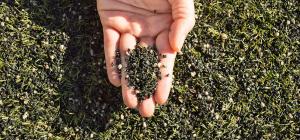
Polybrominated diphenyl ethers (PBDEs) - revised
A Public Health Inspector (PHI) has raised a concern about a local middle school with a small, poorly ventilated computer room containing computers over 10 years old. The PHI has read that brominated flame retardants used in computers can affect reproductive health and is concerned about many students and teachers who spend 20-50% of their school week in this room.
What is the issue?
What are PBDEs?
What are the main sources of human PBDE exposure?
What are the potential human health effects of PBDE?
What are the reference levels for PBDE?
What would be typical computer classroom concentrations?
Where can I learn more?
Acknowledgements
References
Polybrominated diphenyl ethers (PBDEs) are a group of brominated flame retardants that are found in a range of widely used consumer products including electronics and electrical equipment (e.g., television sets, computers, printers, fax machines, and cabling); transportation materials (e.g., plastics and upholstery in cars); and textiles (e.g., carpets and upholstery).1
PBDEs have been widely used since the 1970s; however, due to their persistence in the environment, the manufacturing of PBDEs has been banned and the import, use and sale of PBDEs found in commercial mixtures of greatest concern (penta- and octaBDE) have been restricted in Canada since 2008 and in the US since the end of 2004.1,2 Deca-DBE will be phased out in the US with production, importation, and sales of decaBDE for most uses in the United States to end by the end of 2012, and all uses by the end of 2013, which will eventually have its effect on Canada.3 Despite these bans on PBDEs, there will be a continuous release of these substances from existing products.4
PBDEs are considered ubiquitous; tetraBDE, pentaBDE and hexaBDE have been found in plasma in ~75%, ~26%, and ~42% of the Canadian population, respectively.5 PBDEs are an issue of concern, commonly raised in both school and office settings.
Polybrominated diphenyl ethers (PBDEs) are compounds produced commercially as mixtures of various chemical configurations or congeners. Different congeners have identical base structures but contain various degrees of bromination, anywhere from two to ten bromine atoms, for example tetrabromodiphenyl ether (PBDE-47), pentabromodiphenylether (PBDE-99), hexabromodiphenyl ether (PBDE-153) and decabromodiphenyl ether (PBDE-209). The commercial mixture of tetraBDE and pentaBDE is called PBDE-71.6-9
Three PBDE commercial mixtures were generally used in the manufacturing process: pentaBDE mixture, octaBDE mixture, and decaBDE mixture, named after the predominant congener. The pentaBDE commercial mixture was primarily used in flame-retarded polyurethane (PUR) foams. The octaBDE commercial mixture was primarily used in acrylonitrile butadiene styrene (ABS) resins found in computers and housings appliances. The decaBDE commercial mixture was primarily used in polystyrene (PS) found in electrical and electronic products, as well as in upholstery and drapery fabrics.
PBDEs from products can volatilize directly into the air and find their way into dust as the products age. The lower brominated congeners are more volatile and are thus more likely to be found in air, while the higher brominated congeners are not as volatile and deposit into dust.4 PBDEs are persistent organic pollutants that bioaccumulate in organisms and biomagnify in the food web, and can therefore be found in fatty foods with animal origins. Lower molecular weight PBDEs tend to accumulate more in human tissues (adipose tissue, serum, breast milk) than higher PBDEs, with half-lives varying from a week for decaBDE to 11.5 years for hexaDBE.4 The higher brominated PBDEs (e.g., hepta- to decaBDEs) undergo debromination to form lower brominated congeners (e.g., tetra- to heptaBDEs), which are associated with high levels of bioaccumulation.10 Thus, the presence of a lower brominated congener in the body may be reflective of environmental exposure either to that congener or to the higher brominated PBDEs that have then undergone debromination.5
What are the main sources of human PBDE exposure?
Exposure to PBDEs may occur in many situations in daily life: PBDEs can be found in air, water, soil, sediments, indoor dust, and food. Dietary intake was long considered the most important source of human exposure, but ingestion of dust may also contribute significantly, in particular for children. Infants (0–6 months old) are exposed primarily through breast milk, making up 92% of their total exposure.4
In Canada, the contribution of dust (through intake and dermal absorption) to overall exposure to PBDEs is estimated to be between 40% (adults) and 90% (toddlers), making it the main contributor to overall PBDE exposure. Toddlers have higher exposure because of their proximity to the floor, where they come into contact with house dust.4
Dust levels and concentrations in indoor air of PBDEs are one order of magnitude larger in North America than in Europe. In a worst-case scenario, where dust is highly contaminated with PBDEs (for example 2900 ng g/dw; 2.9 µg/g dw), PBDE exposure is estimated to be 0.290–0.580 µg/day for children and 0.145 µg/day for adults. Dust contains predominantly PBDE-209 (decaBDE), a higher brominated congener that is less volatile.4
Due to biomagnification, exposure to PBDEs is likely to be high for people who regularly eat fatty tissues of high trophic level animals. Still, diet contributes less than 20% to the total exposure to PBDEs. Daily dietary exposure from an omnivorous diet is estimated to be between 0.091–0.117 µg/day.4 Within the diet, (fatty) fish contains the highest levels of PBDEs, with PBDE-47, 99, 100 and perhaps PBDE-49 being the most dominant ones. The levels in fish do not differ between Europe and North America.
In countries where fish constitutes an important part of the diet, such as Japan and some European countries, fish is likely to be the main contributor of dietary PBDEs. Meat, which also has a relatively high fat content, also contributes to total PBDE exposure, but contains lower levels than fish. However, in North America, where less fish is eaten, meat contributes more to the dietary exposure to PBDEs. Meat from North America has higher levels than meat from Europe. Dairy products and oils, especially the ones with a high lipid content, also contain PBDEs, predominantly PBDE-47, 99, and 209. Vegetables contain almost no PBDEs.4
Levels of PBDEs in breast milk and blood are about one order of magnitude larger in North America than in Europe and Asia. The predominant congeners identified in breast milk and other human tissues are PBDE-47, 99, 100, and 153. Studies show that PBDE levels in breast milk increased during the 80s and 90s in Sweden, but now appear to be levelling off, possibly as a result of bans. Differences in dietary habits are unlikely to explain the difference between North America and Europe, but dust might be an important missing link between external (amounts in the environment) and internal (concentrations found in humans) exposure. Differences in dust levels are probably caused by differences in fire regulations between countries.4
What are the potential human health effects of PBDE?
Few human data are available on health effects of individual PBDEs. Of the three commercial mixtures, pentaBDE seems to show toxicological effects at the lowest concentration.4 Animal data suggest effects on the endocrine system (thyroid), neurodevelopmental and neurobehavioural effects and reproductive effects. There is inadequate information to assess carcinogenic potential, except for decaBDE, for which the evidence is “suggestive,” meaning that no studies of cancer in humans exposed to decaBDE are available, but that there is some evidence from animal studies.7
Due to their chemical analogy to thyroid hormones, PBDEs are suspected to alter thyroid function. However, findings from studies in humans are not consistent, with some studies finding negative or no associations with altered thyroid function and concentrations of circulating thyroid hormones.11,12 Studies in rats showed more consistent results, with individual congeners and commercial PBDE mixtures (with doses in the order of tens of mg/kg/day) causing decreased concentrations of circulating thyroid hormones.12 More specifically, perinatal or peripubertal exposure to PBDEs has been shown to cause a reduction in T4 in rodents, while effects on T3 and TSH are less consistent.13
Thyroid hormones are also necessary at very specific points during development,13,14 and diseases of the thyroid gland can affect the reproductive capacity of women. The function of both the ovary and the testis has been altered following in utero exposure to PBDEs with doses in the order of tens to hundreds of µg/kg/day in animals.13 Some PBDEs (including pentaBDE, tetraBDE, and PBDE-71) have been associated with alterations in the sex hormone profile in animals.9,13 In humans, associations were found between levels of PBDEs in serum and lower semen mot/ility (and T4) and sperm concentration.15,16
Animal data also show some evidence for neurodevelopmental toxicity of pentaBDE and hexaBDE: mice orally exposed to these chemicals (doses in mg/kg) in the pre and neonatal periods showed altered neurobehavioural effects that are permanent and that worsen with age.6,9 TetraBDE and pentaBDE have been reported to cause decreased habituation, increased locomotor activity/hyperactivity, cognitive impairment, and altered motor development in mice orally exposed (acute exposure) to these substances in the postnatal period.13,14 Acute neonatal mouse exposure to decaBDE (PBDE-209) (up to 20100 µg) caused dose-related changes in spontaneous behaviour in adult mice. The data indicate that there is a critical window for exposure. In rats, there have been both acute and chronic exposure models showing behavioral changes.7,13,14 Preliminary evidence is available for effects on neurobehaviour in humans: children prenatally exposed to higher concentrations of PBDEs (concentrations in cord blood were 0.012, 0.0032 and 0.0014 µg/g lipid for the PBDE congeners 47, 99, and 100) had lower cognitive and behavioural performance.17,18
Animal data provide some preliminary evidence for neurodevelopmental and reproductive effects of PBDE exposure, but these findings are not always seen in humans. Animal data also suggest that there are populations that are more susceptible to exposure than others, such as foetuses and children.6 Endocrine disruption is of particular concern, as endocrine disruptors have effects at very low doses that are not predicted by effects at higher doses.19 Currently, it is unclear to what extent different PBDEs cause health effects in humans.
What are the reference levels for PBDE?
Health Canada provides a critical effect level of 800 µg/kg/bw (for pentaBDE) based on neurobehavioral effects. Health Canada considers this estimate conservative and consistent with the preliminary nature of screening health assessments.8
Several US organizations have established federal and state guidelines and health standards for PBDEs as follows:
American Conference of Industrial Hygienists (AGGIH) has developed a Workplace Environmental Exposure Level (WEEL) of 5000 µg per cubic meter (5000 µg/m3) for decaBDE. Ongoing air monitoring is required if dust levels of pentaBDE and octaBDE exceed 5000 µg/m3.
The Agency for Toxic Substances and Disease Registry (ATSDR) has set a minimal risk level for intermediate (14–364 days) oral exposure of 10000 µg /kg/day for decaBDE.
The US EPA has established oral Reference Doses (RfDs) for PBDEs: 7 µg/kg/day (decaBDE), 3 µg/kg/day (octaBDE), and 2 µg/kg/day (pentaBDE).9 20
What would be typical computer classroom concentrations?
Due to their physico-chemical properties, PBDEs are present in the air and in the dust of indoor environments. Studies have been conducted in homes and in offices. A typical computer classroom is likely more comparable to offices than to homes.
PBDEs have been found in house dust, varying from a median concentration of 0.950 µg/g in Toronto,21 1.35 µg/g in Vancouver,22 and 1.8 µg/g in Ottawa.23 No data are available on dust levels in offices in Canada, but in the US, the dust concentration of the sum of PBDEs in offices was found to be 8.75 µg/g.24 Given the fact that dust levels are generally higher in the US than in Canada,25 it is uncertain whether data from US offices can be extrapolated to Canada.
The intake of contaminated dust from a computer classroom is likely in the order of hundreds of ng/day, which is lower than established reference doses (i.e., the lowest level of exposure at which health effects occur) that are generally in the order of mgs or µgs per kg bodyweight per day, although effects in humans have been shown at low doses.17 It is uncertain how much the computer classroom exposure contributes to the overall exposure of children and teachers, and whether these low levels will result in health effects.
PBDE levels in indoor air of workplaces are higher than those in homes.25 One study of Ottawa homes reported mean and median airborne levels of total PBDEs of 0.00026 µg/m3 and 0.0001 µg/m3 respectively.26 In offices in Toronto, a median concentration of the sum of PBDEs in indoor air of 0.00014 µg/m3 (0.000025–0.00035 µg/m3) was found.27 Concentrations of the sum of PBDEs in indoor air range from 0.001082 µg/m3 in UK offices to 0.00126 µg/m3 in US offices and 0.004 µg/m3 in Swedish offices.25 However, since inhalation of contaminated indoor air is thought to contribute little to overall exposure to PBDEs,4 dust concentrations are far more important to assess exposure and the potential for health effects.
How can PBDE exposure be reduced?
Although the contribution to daily intake of PBDEs from a computer classroom is unknown, school authorities may wish to reduce exposures as much as possible. One of the most effective methods to reduce PBDE exposure in a classroom environment is to remove or replace old electronic equipment, furniture, and carpets. Where that is not possible, other options can include:
- Regular HEPA vacuuming of carpets and upholstered furniture and wet-wiping of surfaces to reduce dust levels;
- Encouraging hand-washing to reduce manual ingestion of dust;
- Prohibiting eating in the room to reduce inadvertent ingestion;
- Limiting the number of electronic appliances in the room or limiting the time spent in the room.
One University of Toronto case study found that replacing an older computer effectively decreased PBDE concentrations in air and dust. This study also observed that improved ventilation must be accompanied by dust removal (vacuuming) in order to be effective.28
Health Canada “It’s Your Health” article is available at: http://www.hc-sc.gc.ca/hl-vs/iyh-vsv/environ/pbde-eng.php.
Government of Canada “Chemical Substances” information is available at: http://www.chemicalsubstanceschimiques.gc.ca/fact-fait/pbde-eng.php.
Appendix 1: PBDEs – Further Reading
Acknowledgements
We would like to thank the following individuals for their valuable input and review of this document: Tim Foggin and Hannah Moffat for initial research and write-up; Erna van Balen for additional research and revised document write-up; Patti Dods, Mary Albert, Frano La Ricca and Brian Giles for review and comments. Additional thanks to Michele Wiens and Patricia Fortin for document revision and bibliographical assistance.
References
- Chemical Substances. Polybrominated diphenyl ethers (PBDEs). Ottawa, ON: Government of Canada; [cited 2012 Aug 21].
- Natural Resources Defense Council. Healthy milk, healthy baby - chemicals: PBDE. New York, NY: National Resources Defense Council, [cited 2012 Oct 16].
- U.S. Environmental Protection Agency. An exposure assessment of polybrominated diphenyl ethers (PBDE) (final). Washington, DC: EPA; 2010 [updated Jan 13, 2011].
- Frederiksen M, Vorkamp K, Thomsen M, Knudsen LE. Human internal and external exposure to PBDEs - a review of levels and sources. Int J Hyg Environ Health. 2009;212(2):109-34.
- Health Canada. Report on human biomonitoring of environmental chemicals in Canada. Results of the Canadian Health Measures Survey Cycle 1 (2007–2009). Ottawa, ON: Health Canada; 2010.
- U.S. Environmental Protection Agency. Toxicological review of 2,2’,4,4’,5,5’-hexabromodiphenyl ether (BDE-153) (CAS No. 68631-49-2). Washington, DC2008. Report No.: EPA/635/R-07/007F.
- U.S. Environmental Protection Agency. Toxicological review of decabromodiphenyl ether (BDE‑209) (CAS No. 1163-19-5). Washington, DC2008. Report No.: EPA/635/R-07/008F.
- U.S. Environmental Protection Agency. Toxicological review of tetrabromodiphenyl ether (BDE‑47) (CAS No. 5436-43-1). Washington, DC2008. Report No.: EPA/635/R-07/005F.
- U.S. Environmental Protection Agency. Toxicological review of pentabromodiphenyl ether (BDE‑99) (CAS No. 60348-60-9). Washington, DC2008. Report No.: EPA/635/R-07/006F.
- Environment Canada. Ecological screening assessment report on polybrominated diphenyl ethers (PBDEs), 2006.
- Andra SS, Makris KC. Thyroid disrupting chemicals in plastic additives and thyroid health. J Environ Sci Health [C]. 2012;30(2):107-51.
- Boas M, Feldt-Rasmussen U, Main KM. Thyroid effects of endocrine disrupting chemicals. Mol Cell Endocrinol. 2012;355(2):240-8.
- Talsness CE, Andrade AJ, Kuriyama SN, Taylor JA, vom Saal FS, Talsness CE, et al. Components of plastic: experimental studies in animals and relevance for human health. Philos Trans R Soc Lond B Biol Sci. 2009 Jul 27;364(1526):2079-96.
- Messer A. Mini-review: polybrominated diphenyl ether (PBDE) flame retardants as potential autism risk factors. Physiol Behav. 2010;100(3):245-9.
- Abdelouahab N, AinMelk Y, Takser L. Polybrominated diphenyl ethers and sperm quality. Reprod Toxicol. 2011;31(4):546-50.
- Akutsu K, Takatori S, Nozawa S, Yoshiike M, Nakazawa H, Hayakawa K, et al. Polybrominated diphenyl ethers in human serum and sperm quality. Bull Environ Contam Toxicol. 2008;80(4):345-50.
- Herbstman JB, Sjödin A, Kurzon M, Lederman SA, Jones RS, Rauh V, et al. Prenatal exposure to PBDEs and neurodevelopment. Environ Health Perspect. 2010;118(5):712-9.
- Roze E, Meijer L, Bakker A, Van Braeckel KNJ, Sauer PJJ, Bos AF. Prenatal exposure to organohalogens, including brominated flame retardants, influences motor, cognitive, and behavioral performance at school age. Environ Health Perspect. 2009;117(12):1953-8.
- Vandenberg LN, Colborn T, Hayes TB, Heindel JJ, Jacobs DR, Lee D-H, et al. Hormones and endocrine- disrupting chemicals: low-dose effects and nonmonotonic dose responses. Endocr Rev. 2012 Mar
- U.S. Environmental Protection Agency. Technical fact sheet – polybrominated diphenyl ethers (PBDEs) and polybrominated biphenyls (PBBs). Washington, DC: US EPA; 2012.
- Harrad S, Ibarra C, Diamond M, Melymuk L, Robson M, Douwes J, et al. Polybrominated diphenyl ethers in domestic indoor dust from Canada, New Zealand, United Kingdom and United States. Environ Int. 2008 Feb;34(2):232-8.
- Shoeib M, Harner T, Webster GM, Sverko E, Cheng Y. Legacy and current-use flame retardants in house dust from Vancouver, Canada. Environ Pollut. 2012;169(0):175-82.
- Wilford BH, Shoeib M, Harner T, Jiping Z, Jones KC. Polybrominated diphenyl ethers in indoor dust in Ottawa, Canada: implications for sources and exposure. Environ Sci Tech. 2005;39(18):7027-35.
- Batterman S, Godwin C, Chernyak S, Jia C, Charles S. Brominated flame retardants in offices in Michigan, U.S.A. Environ Int. 2010;36(6):548-56.
- Besis A, Samara C. Polybrominated diphenyl ethers (PBDEs) in the indoor and outdoor environments – a review on occurrence and human exposure. Environ Pollut. 2012 Oct;169:217-29.
- Wilford BH, Harner T, Jiping Z, Shoeib M, Jones KC. Passive sampling survey of polybrominated diphenyl ether flame retardants in indoor and outdoor air in Ottawa, Canada: implications for sources and exposure. Environ Sci Tech. 2004;38(20):5312-8.
- Zhang X, Diamond ML, Robson M, Harrad S. Sources, emissions, and fate of polybrominated diphenyl ethers and polychlorinated biphenyls indoors in Toronto, Canada. Environ Sci Tech. 2011;45(8):3268-74.
- Zhang X. Measurement and modeling of polybrominated diphenyl ethers (PBDEs) and polychlorinated biphels (PCBs) in the indoor environment [Master's thesis thesis]. Toronto, ON: University of Toronto; 2008.
April 2013








